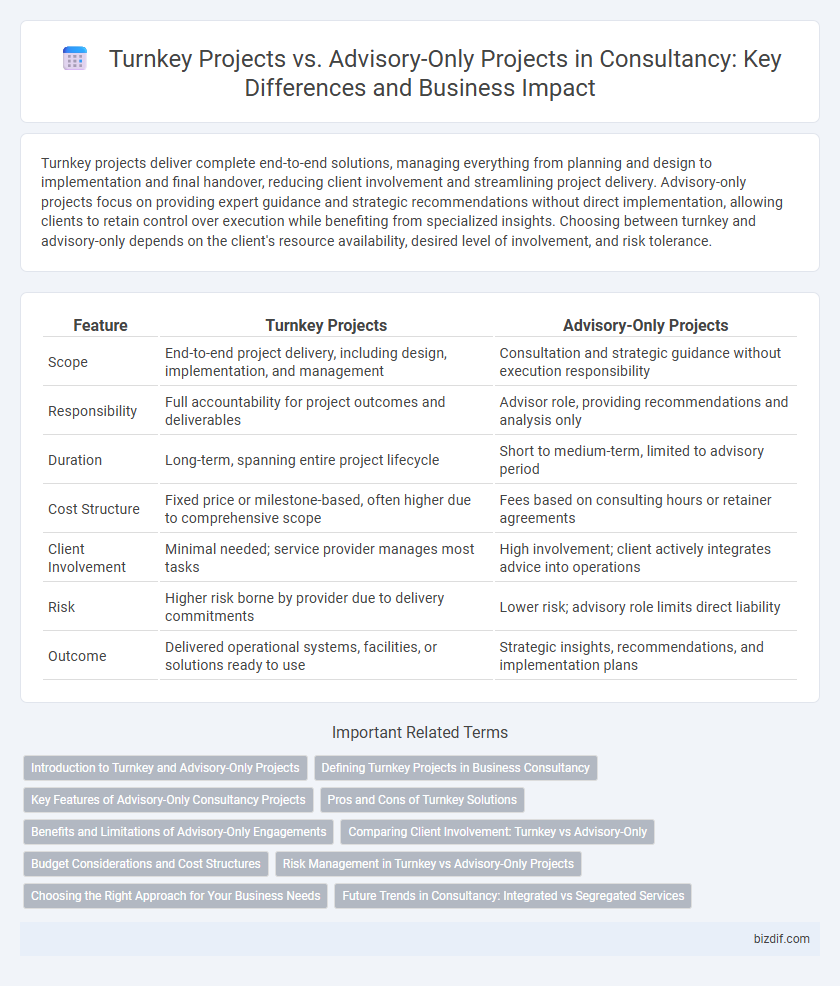Turnkey projects deliver complete end-to-end solutions, managing everything from planning and design to implementation and final handover, reducing client involvement and streamlining project delivery. Advisory-only projects focus on providing expert guidance and strategic recommendations without direct implementation, allowing clients to retain control over execution while benefiting from specialized insights. Choosing between turnkey and advisory-only depends on the client's resource availability, desired level of involvement, and risk tolerance.
Table of Comparison
| Feature | Turnkey Projects | Advisory-Only Projects |
|---|---|---|
| Scope | End-to-end project delivery, including design, implementation, and management | Consultation and strategic guidance without execution responsibility |
| Responsibility | Full accountability for project outcomes and deliverables | Advisor role, providing recommendations and analysis only |
| Duration | Long-term, spanning entire project lifecycle | Short to medium-term, limited to advisory period |
| Cost Structure | Fixed price or milestone-based, often higher due to comprehensive scope | Fees based on consulting hours or retainer agreements |
| Client Involvement | Minimal needed; service provider manages most tasks | High involvement; client actively integrates advice into operations |
| Risk | Higher risk borne by provider due to delivery commitments | Lower risk; advisory role limits direct liability |
| Outcome | Delivered operational systems, facilities, or solutions ready to use | Strategic insights, recommendations, and implementation plans |
Introduction to Turnkey and Advisory-Only Projects
Turnkey projects involve delivering a complete, ready-to-use solution where the consultancy manages every phase from design to implementation, ensuring seamless integration and accountability. Advisory-only projects focus exclusively on providing expert recommendations, analysis, and strategic guidance without direct involvement in execution or operational management. Understanding the distinction helps businesses choose between full-service project delivery and specialized consultative support based on their needs and resource capabilities.
Defining Turnkey Projects in Business Consultancy
Turnkey projects in business consultancy involve delivering comprehensive, fully operational solutions where the consultant manages the entire project lifecycle from planning to implementation, ensuring a ready-to-use outcome for the client. These projects demand extensive resource coordination, risk management, and strict adherence to timelines and budgets to meet specific client objectives. This approach contrasts with advisory-only projects, which focus solely on providing expert recommendations without responsibility for execution or delivery.
Key Features of Advisory-Only Consultancy Projects
Advisory-only consultancy projects focus on providing expert guidance and strategic recommendations without direct involvement in implementation, emphasizing analysis, risk assessment, and decision support. These projects prioritize delivering actionable insights, market research, and feasibility studies to empower clients in making informed business decisions. This approach offers flexibility, reduced resource commitment, and supports long-term planning by leveraging specialized knowledge and industry best practices.
Pros and Cons of Turnkey Solutions
Turnkey projects offer clients a comprehensive solution with a single point of accountability, reducing complexity and ensuring streamlined project delivery. However, they may limit client control and flexibility during implementation, potentially leading to solutions that are less customized to specific organizational needs. The fixed scope and timeline can also increase risk if unexpected changes arise, making adaptability a key drawback compared to advisory-only projects.
Benefits and Limitations of Advisory-Only Engagements
Advisory-only projects provide tailored strategic insights without the responsibility for implementation, offering clients flexibility and control over execution. These engagements limit consultants' involvement, which can restrict the ability to ensure outcomes align closely with recommendations. Clients benefit from cost-effective expert guidance but face potential risks of inconsistent application and delayed results due to reliance on internal resources.
Comparing Client Involvement: Turnkey vs Advisory-Only
Turnkey projects require minimal client involvement as the consultancy manages the entire process from design to implementation, delivering a fully operational solution. In contrast, advisory-only projects demand high client engagement, with consultants providing strategic guidance while clients retain control over execution and decision-making. This comparison highlights the trade-off between hands-off project delivery in turnkey models and collaborative, client-driven progress in advisory-only engagements.
Budget Considerations and Cost Structures
Turnkey projects typically involve a fixed budget with clearly defined deliverables, allowing for streamlined cost structures that cover end-to-end implementation, reducing financial risks for clients. Advisory-only projects usually have variable budgeting tied to hourly rates or retainer fees, reflecting a more flexible, consultative engagement without direct implementation costs. Understanding these budget considerations helps organizations allocate resources effectively and choose the most cost-efficient consultancy model based on project scope and financial constraints.
Risk Management in Turnkey vs Advisory-Only Projects
Turnkey projects in consultancy involve comprehensive risk management by transferring project risks to the contractor, ensuring fixed scope, cost, and timeline commitments. Advisory-only projects focus on identifying and mitigating risks through recommendations without assuming direct accountability for outcomes, leaving risk responsibility primarily with the client. Effective risk management in turnkey projects often results in higher predictability and reduced client exposure compared to advisory-only engagements.
Choosing the Right Approach for Your Business Needs
Turnkey projects deliver end-to-end solutions, offering businesses a fully operational system tailored to their specifications, ideal for clients seeking comprehensive management and minimal internal resource allocation. Advisory-only projects provide strategic guidance and expert recommendations without implementation, best suited for organizations with in-house capabilities aiming to optimize specific areas or make informed decisions. Selecting the right approach depends on factors such as project scope, internal expertise, budget constraints, and desired control over execution processes.
Future Trends in Consultancy: Integrated vs Segregated Services
Turnkey projects consolidate design, implementation, and delivery into a single contract, enabling faster execution and streamlined accountability. Advisory-only projects focus exclusively on strategic guidance without direct involvement in execution, allowing clients more flexibility but requiring stronger internal project management. Future trends in consultancy emphasize integrated services that combine advisory insights with implementation capabilities, enhancing value through seamless collaboration and end-to-end solutions compared to segregated service models.
Turnkey projects vs Advisory-only projects Infographic

 bizdif.com
bizdif.com